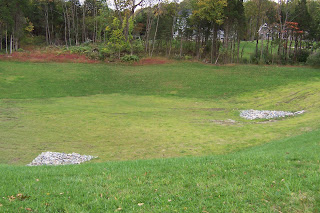Making Your Creative Mark In Gardening – Part 1
I’m pleased to share with you an excerpt from a new book by America’s foremost creativity coach and my writing mentor, Dr. Eric Maisel. It’s called, Making Your Creative Mark. While Eric works primarily with authors and fine, craft, and performing artists, I’ve always found his approach to be directly applicable to my work with Cultivating The Inner Gardener.
I’ve added editorial comments to the excerpt to help you see how you can use Eric’s suggestions to express more of your own creativity in the garden.
Passion and Voice
ERIC: A logical — and vital — relationship exists between passion and voice. It is very hard to be passionate about what you’re doing if you haven’t found your voice as an artist. Imagine being forced to sing an octave too high or an octave too low, straining to hit notes that you can’t really hit and that aren’t natural to you. It would be very hard to be passionate about singing in that situation.
LOIS: Couldn’t you just feel the muscles of your throat tighten as you read that? It’s the same with gardening. When we try to force ourselves to mimic a garden style that isn’t compatible with our personality and values, or duplicate gardens from books and magazines that are intended as inspiration, we short-circuit our creative instincts and passion for gardening.
ERIC: It is exactly like that with respect to whatever art you are creating. Whether you have been forced by circumstance not to create in your own voice, or whether you’ve avoided creating in your own voice for psychological reasons, the result will be a tremendous lack of passion for what you’re doing. Creating in your authentic voice produces and sustains passion.
With that in mind, here are ten tips for finding or reclaiming your voice. They are framed in terms of visual art, so if you are not a visual artist you will need to translate them so that they make sense for your art discipline.
1. Detach from your current visual library. A very common problem, and almost always an unconscious one, is the need an artist feels to make his work look like something he holds as “good art” or “real art” — very often Old Master art. Because he possesses an internal library of the successful artworks of well-known artists, without quite realizing that he is doing it, he aims his art in the direction of those successes. It is vital that an artist detach from that visual library — extinguish it, as it were — so that his own imagery has a chance to appear.
LOIS: This is the exact opposite of the advice I normally give my clients, but take a holiday from your usual sources of garden imagery – favorite books, magazines, public gardens, etc. Go on a mental retreat. If you plan to vacation in a different climate, visit a public garden while you’re there to see how different gardens can be from one another. If you garden in a formal style, go hiking in a natural area; if you love naturalistic gardens, visit some highly stylized ones.
ERIC:
2. Try not to rest on skills and talent. Maybe you excel at producing dynamic-looking cats or turning a patch of yellow into a convincing sun. That you have these talents doesn’t mean that you ought to be producing lifelike cats or brilliant suns. Your strongest subject matter and style choices depend on what you want to say rather than on what you are good at producing. By all means, parlay your skills and talents — but don’t rely on them so completely that you effectively silence yourself.
LOIS: Thinking about what you want your garden to say is a new wrinkle for most gardeners, who are generally preoccupied with how the garden looks, what can be done in it, or whether favored plants can thrive there. For example, I want my garden to say that it arose out of the woods on its own and offers shelter to all living beings.
ERIC:
3. Allow risk-taking to feel risky. Very often the personal work you want to do feels risky. Intellectually, you may find a way to convince yourself that the risk is worth taking — but when you try to take the risk, you balk because you suddenly feel anxiety welling up. Remember that a risk is likely to feel risky. Get ready for that reality by practicing and owning one or two robust anxiety-management strategies.
LOIS: Post-Hurricane Sandy we took a lot of gardening risks, including uprighting a 40-foot cedar tree when we weren’t sure it could survive, restoring a major part of the garden when we were concerned about making expensive mistakes, and moving perennials at the wrong time into marginally compatible spaces. Our “robust anxiety-management strategy” was that doing nothing was not an option.
Excerpted from the new book Making Your Creative Mark ©2013 by Eric Maisel. Published with permission of New World Library http://www.newworldlibrary.com
MORE NEXT TIME…..


